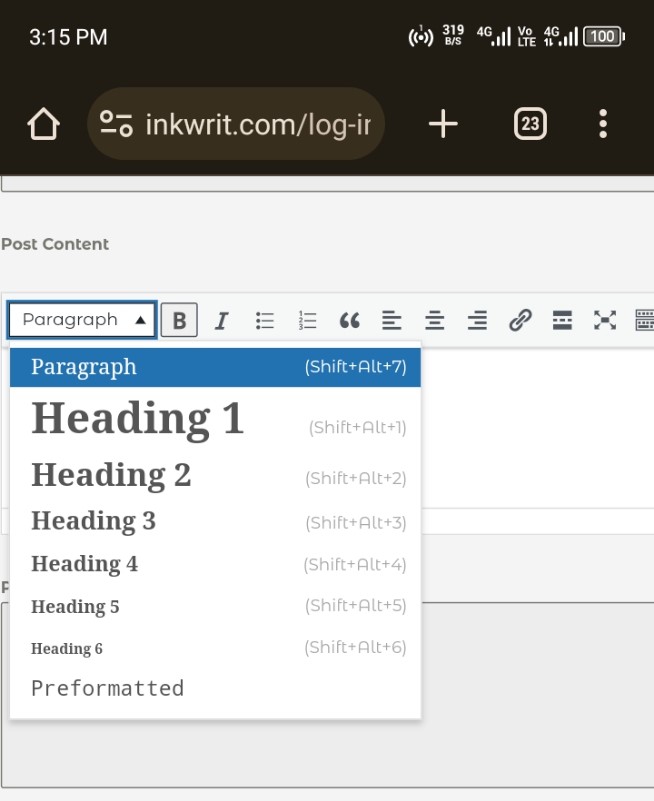I have been writing articles for months, and I can say that what I know about SEO has improved. One of such things I have come to learn is on page SEO optimization.
As a beginner you might be wondering what is on page SEO optimization? On page SEO optimization is a SEO term that refers to all the general activities such as optimizing your title tags, header tags, URLs, alt text, and others you can carry out on an article to make it rank on Google.
As a newbie, these activities could still be difficult for you to piece together and that’s ok, here’re two solutions I can prescribe for you right now; 1. Create your SEO account with us at inkwrit. 2. After reading this article I want you to put to practice all that you’ve learned and submit the article to us for review.
It’s true that search engine optimization can be very complex when you’re trying to understand it for the first time, I found it difficult too, however it becomes very easy when you can:
- Relate it to general concepts that you might already have an understanding of.
- Know the meaning of the term associated with it and how it work.
Now let’s dive in…
What Is On Page SEO Optimization?
On page SEO optimization, as the name suggests, is the practice of optimizing your articles to rank higher and get relevant traffic from the search engine.
On page SEO optimization also includes HTML source code optimization. HTML source code optimization involves the general HTML optimization activities website owners carry out on their websites to get their sites easily accessed, understood, and indexed by Google. In this article we’ll focus on page article/content optimization.
On Page SEO Optimization and How It Works
Goggle has hundreds of ranking factors that you and I can’t impact on however when it comes to on page SEO optimization, you can have direct impact. A little tweak on your article can make you drive huge organic traffic to a site. But the question is how do you achieve this? The primary answers are:
1. Title Tag
This is also called a page title and it’s what tells the search engine and browsers the subject of your article. The page title influences both the click through rates and people’s first impressions of our article on the web. According to Semrush here are the various ways a title tag is presented:
- As HTML

- On Chrome

- On Google search result pages

- In a link preview on Slack

2. Meta Descriptions
The Meta description is a short snippet of your article and it’s usually between 155-160 words depending on the search engine. It does not influence rankings, but it does influence clicks. People will see your snippet or your page information in the search engine results.
The gray text in the search result is the Meta description just as you see in this pic from Moz.

A Meta description can be pulled randomly by engines if you fail to provide one. You can write a good Meta description and improve the chances of it appearing if you write a short but catchy descriptive phrase of the content or the purpose of the page.
3. Headings (H1, H2, H3, etc.)

Now let’s go to the next ranking factor, the header tags. These are also referred to as the heading and subheading found in an article.
Headings help you to build a hierarchy of information for your article. It’s advised you start with the H1
Like a newspaper, there’s only one main headline per page. It describes the main purpose of the page. Then a subheading, the H2 etc. This is how you break your sub content into subcategories.
At this junction, your keyword should be part of your H1 and then use secondary keywords in your H2 etc.
The key is to keep it short. Now putting the keyword in these headings alone is not the only factor that make not your page optimized. Remember, the purpose is to provide a quick reference for people to find the content they need within seconds.
4. Keywords
Keyword are words or phrases what people search for online. In addition they help search engines like Google understand what your content is about.
Types of keywords
There are four types of keywords and they are:
- Short-tail: broad terms e.g., writing tips.
- Long-tail: specific phrases e.g., SEO writing tips for beginners.
- Primary: main focus e.g., SEO writing.
- Secondary: supporting words e.g., content optimization.
How to use keywords
- Use them naturally in your content.
- Aim for 1-2% keyword density.
- Mix in variations and synonyms.
- Research keywords with tools like Google Keyword Planner.
Why keywords matter
- Improve your content’s search engine ranking.
- Increase visibility and traffic.
- Engage your target audience.
- Boost credibility.
Your SEO writing checklist
- Choose relevant keywords.
- Write high-quality, engaging content.
- Optimize keywords naturally.
- Research and refine.
5. URL Structure
Now if we go back to the search engine results page, the SERP, there is another element in that listing called the URL. The page title is the large blue text. The Meta description is the gray text.
Now the gray text on the top of the page title is the URL. E.g. http://example.com/blog/post/12345
Just like the address for your home, the Internet knows that the URL is the address for that page. This is extremely important for SEO for a variety of reasons.
- People also copy and paste URLs into mobile messages, emails, and social links.
- Helps users access your content easily.
- It enables easy sharing.
- It helps enables tracking.
It is extremely important to keep these short, succinct, and I like to say, readable.
6. Content Quality
Focus on writing content that engages with your visitors and uses language naturally. Writing high-quality content is key to online success. It builds trust, enhances user experience, and boosts search engine rankings.
To improve, track metrics like engagement, conversions, and search rankings. Refine your content by:
- Knowing your audience
- Researching thoroughly
- Planning and editing carefully
- Using multimedia elements
Learn to prioritize content quality to establish your brand and drive growth.
7. Image Optimization
Part of the things that can get your article to rank is image optimization. If you’re writing for a client you might want to attach an alt text to every images you used in your article. An alt text is a description of the images that you’ve made used of in your article. It’s also advisable that you add your primary keyword in your alt text. Why using alt text is very important it’s because this alt text helps visually impaired users to know what the image is all about since they can’t see them.
Also search engines use this alt text description to gain additional context about the page, the content of the image, and its purpose.
8. Internal Linking
You can’t talk about on page optimization without speaking about internal link. Internal link is a link from 1 page on a website to another page of the same website. Now if you’re writing for client you might want to take note of their existing content so that you can inter link. This is important improves page relevancy.
Likewise when you inter link articles, what you’re showing to search engines and to humans is that this section, if you click on this link, they will find more related information to what you’re talking about in your article.
9. Social Sharing
Though it is said that social media sharing is not a core ranking factor for search engines like Google, however it does help the engines know how relevant your content is when people share them on social platforms.
What Not to Do as Regard On Page SEO Optimization
We’ve covered a lot of things that are important and things that you should be doing when optimizing your on-page content.
Now let’s go a different direction and cover things that you should not be doing as regard on page optimization and they are:
Keyword stuffing:
Keyword stuffing is the over use of keywords in your content. Those days, people could do keyword stuffing and get away with it, but now the search engines, are very smart about this, and they can get you penalized when you fall a victim. Thus focus on writing content that engages with your client’s visitors and use language naturally.
Hidden text:
This is when you write content that is solely for search engines and not for people. Now typically it is attempted by writing a lot of repetitive keywords as text, coloring it white, and placing it against a white background. As you see, this was developed as another way to add more keyword stuffed text without the user seeing the overuse of keywords. Now it didn’t work too well in the past, and it definitely does not work today. This tactic backfires in 2 ways.
First, search engines can tell when it’s white text on a white background. It’s easy to tell from a computer science point of view. Search engines read the HTML and in the HTML are the instructions for colors. When you hide text, modern search engines are smart enough to figure it out, probably better than a human. Now secondly, it’s done to hide repetitive keyword stuff text, which is the second thing against you. These outdated unprofessional tactics will most likely get your client’s website penalized by the search engines.
Wrapping up
The importance of on page SEO optimization can never be overemphasized, in as much as this is true, you can’t become acquainted with these optimization rules without practice and continuous practicing till they become part of you. However without having a website practicing might become challenging this is why I would encourage you to sign up with us today and start writing.




